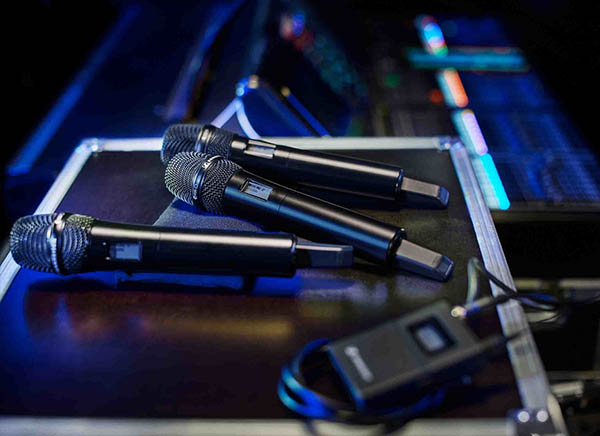
Sennheiser has announced that the first EW-DX devices are shipping in North America, EMEA, Japan, and Singapore. Available products include the EW-DX EM 2 two-channel receiver, the handheld transmitter – with or without a programmable mute switch – and the bodypack transmitter. The latter also comes in two versions, either with a special 3-pin mic connector or a 3.5 mm (1/8”) jack for mics or instrument cables. Convenient set packages are available, too, with further, higher frequency variants ready in Q1 2023, and more EW-DX devices and software being added to the line in mid-2023.
Benny Franke, product manager at Sennheiser said “This awesome system combines pro features and ease of use in well-designed, rugged housings. We’re happy to see it hitting the market.”
He added “EW-DX is a more than worthy technological successor to the evolution wireless G4 series and will be setting a new standard in the live audio industry for simplicity, reliability, audio quality and frequency efficiency.”
EW-DX simplifies workflows and brings exciting features set to any application.
EW-DX offers the lowest latency on the market (1.9 milliseconds), eliminates the need for frequency calculation, and offers an ultra-wide input dynamic range of 134 dB, enabling your transmitters to handle any signal that is thrown at them. Their operating time is 12 hours with the BA 70 rechargeable battery, which will usually take you through rehearsals and the show or event itself. Operating time with standard AA batteries amounts to eight hours. Depending on the RF environment, the transmitters have a range of up to around 100 m, enough even for very generous stage layouts.
The automatic multi-channel RF setup, scalable remote control and monitoring, and AES-256 encryption for safe content delivery are further advantages of EW-DX systems. Up to 88 MHz of additional bandwidth than with EW-D allows for the support of more channels.
As part of the Evolution Wireless Digital family, EW-DX is respectful towards the valuable resource that is the RF spectrum – and takes the complexities out of wireless at the same time.
Carefully engineered, the systems do not generate any significant intermodulation products. From a spectrum efficiency point of view, this means that the microphones do not pollute the available spectrum with their intermodulation products, hence more transmission frequencies can be used and distributed evenly at regular distances (the so-called equidistant frequency grid or tuning grid). A frequency calculation is no longer needed, making your job easier.
In standard mode – i.e. with an equidistant frequency spacing of 600 kHz – EW-DX accommodates up to 146 links within its switching bandwidth, and up to 293 frequencies in Link Density Mode (LD, at 300 kHz spacing). This just comes at the expense of approx. 10% of the range, so you will have the same great audio quality and transmission power in LD mode, too.
EW-DX offers two bodypack transmitter options: the EW-DX SK, which has a 3.5 mm jack for instrument cables and microphones, and the EW-DX SK 3-PIN, which has a specific three-pin connector for microphones. Any digital-proof Sennheiser clip-on and headset mic, the Neumann MCM system, and digital-proof third-party mics can all be utilised with the bodypacks.
The portable microphone is also offered in two variations: one with an EW-DX SKM-S noiseless, programmable mute button and the other without one (EW-DX SKM). The mute switch can be set to “off,” “AF Mute,” or “RF Mute”; the latter allows you to make inaudible settings changes or to maintain a backup microphone on hand. For the portable, there are 14 different Sennheiser and Neumann microphone heads available (standard Sennheiser capsule interface).
All transmitters feature a trim control so they can alternate on the same receiver channel – for example when multiple guitars are used – and still have the same level on the mixing desk. For guitarists and bassists who do not want to miss that typical cable sound, the EW-DX SK bodypack offers a three-step cable emulation.
The EW-DX transmitters are the first ones available on the market with e-ink displays; even when they are turned off, you can still read off crucial transmitter data. Additionally, they have a low cut that can be adjusted to lower handling noise or pop noise during broadcasts. Off, 30 Hz, 60 Hz, 80 Hz, 100 Hz, and 120 Hz are the available settings. All transmitters have built-in test tones and charging connectors that enable the BA 70 battery to be charged while the device is being used.
The transmitters’ green status LED may be turned off, which is a crucial feature in more private performance spaces or broadcast environments. The display brightness can also be modified, and all settings can be locked.
The EW-DX EM 2 is the first two-channel receiver to launch in the series. It is an ideal choice for users that do not require a digital audio output, which will become available with the two Dante-enabled receivers in mid-2023.
The Auto Scan feature on the EW-DX EM 2 will help you locate effective frequencies for your receiver or several networked receivers. Bluetooth® Low Energy makes it simple to sync transmitters: There is no need to hunch over in front of your rack to make sure the transmitters can see the receiver. Even better: you can pick and choose the parameters you want to switch. You can choose merely to adjust the transmission frequency, leaving the other transmitter settings alone.
The receiver is fitted with headphone output with volume control, both balanced XLR and unbalanced 6.3 mm analogue outputs, and an RJ 45 port for Power over Ethernet and integration into control and monitoring networks. An OLED display shows both channels at a glance, and a link quality indicator helps avoid surprises.